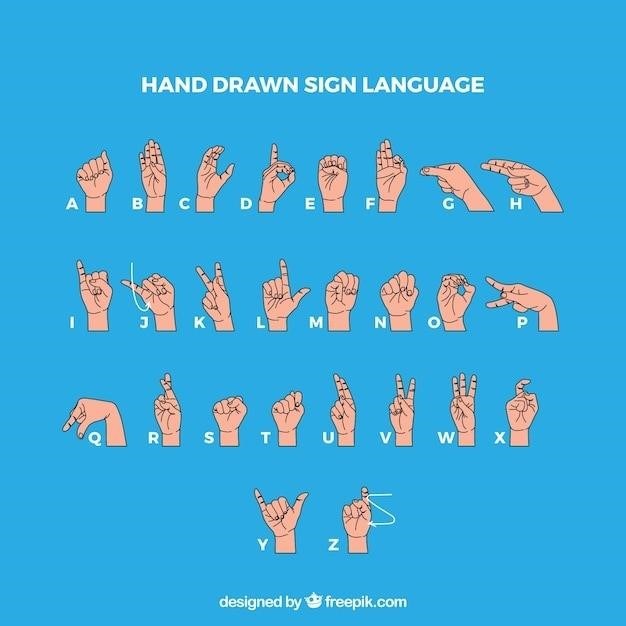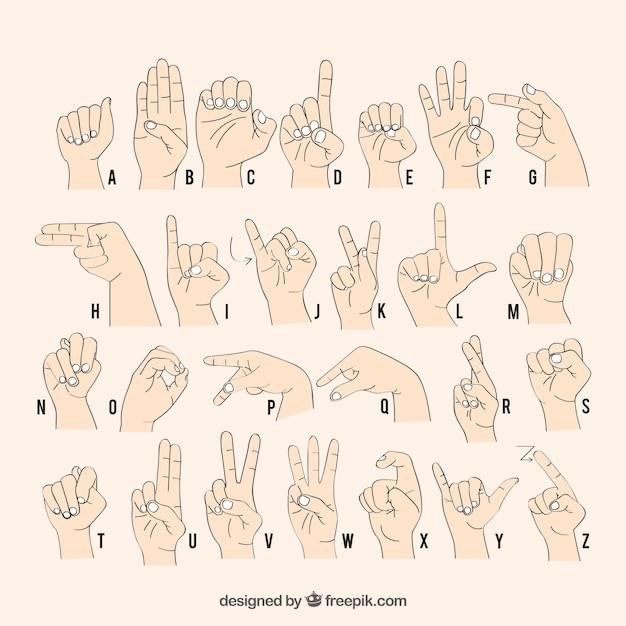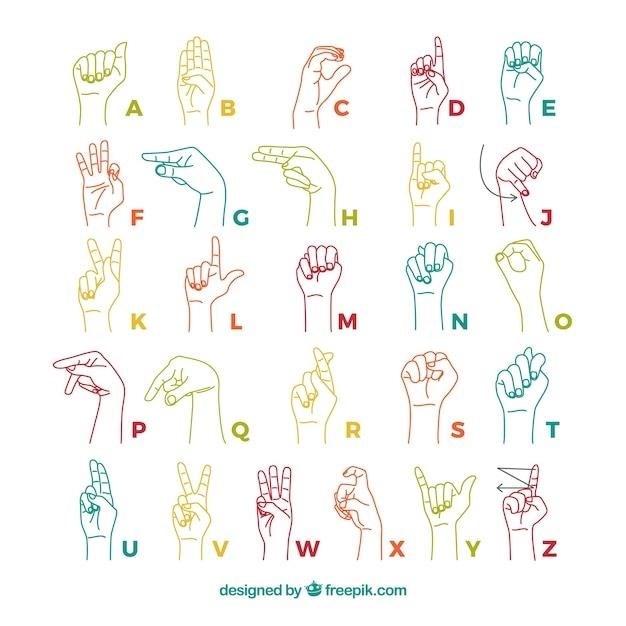Learning the ASL Alphabet
The American Sign Language (ASL) alphabet is a crucial foundation for learning and using ASL. It provides a visual representation of English letters, allowing individuals to spell out words and names when signing. Free downloadable resources, such as PDFs and charts, are readily available online, making it easy to learn the ASL alphabet. These resources often include images or videos of the handshapes for each letter, making the learning process more engaging and effective.
Downloadable Resources
The internet is brimming with readily available resources for learning the ASL alphabet, particularly in the form of downloadable PDFs. These PDFs offer a convenient and accessible way to learn the alphabet at your own pace. They often include clear visuals of the handshapes for each letter, accompanied by the corresponding English letter. Some PDFs even offer additional information, such as the history of the ASL alphabet, tips for memorization, and practice exercises.
These downloadable resources are a valuable tool for anyone interested in learning ASL, whether they are just starting out or looking to improve their skills. They provide a comprehensive and portable way to access the ASL alphabet, making it easy to learn and practice anytime, anywhere.
Free ASL Alphabet PDFs
The internet offers a wealth of free ASL alphabet PDFs, making learning this essential aspect of ASL accessible to everyone. These PDFs typically feature clear images of the handshapes for each letter, alongside the corresponding English letter. Some PDFs also include additional information such as the history of the ASL alphabet, tips for memorization, or even practice exercises.
These free resources are a valuable tool for individuals who are just beginning their ASL journey, as they provide a convenient and cost-effective way to learn the alphabet. They can be downloaded and printed, making them easily accessible for study and practice.
ASL Alphabet Charts
ASL alphabet charts are a visually appealing and practical way to learn and reference the ASL alphabet. These charts typically feature a clear and organized layout, with each letter represented by an image of the corresponding handshape. Some charts may also include the English letter alongside the handshape, making it easier for learners to connect the visual representation with the written form.
ASL alphabet charts are often available in both printable and digital formats, allowing learners to choose the format that best suits their needs. They can be used for individual study, group learning, or even as a visual aid in classroom settings.
These charts are a valuable resource for individuals of all levels, from beginners to those who are more advanced in their ASL journey. They provide a clear and concise visual reference for the ASL alphabet, making it easier to learn and remember the handshapes for each letter.
The Importance of the ASL Alphabet
The ASL alphabet plays a vital role in communication within the Deaf community. While ASL is a complete language with its own grammar and syntax, the alphabet is crucial for spelling out words and names that don’t have established signs. It is also used to clarify the meaning of a sign, especially when there are multiple signs for a single word.
The ASL alphabet is particularly important when interacting with individuals who are hearing but are unfamiliar with ASL. It allows for a shared understanding of written words and concepts, bridging the communication gap between hearing and Deaf individuals.
For those learning ASL, the alphabet serves as a foundational element, providing a visual representation of English letters and helping learners develop their signing skills. Mastering the ASL alphabet is a fundamental step toward fluency in the language and fosters a deeper connection with the Deaf community.

Using the ASL Alphabet
The ASL alphabet is a fundamental tool for effective communication within the Deaf community. It allows for the spelling of words and names that lack established signs, enabling clear and accurate communication.
Communication with Deaf and Hard of Hearing Individuals
The ASL alphabet plays a vital role in facilitating communication with Deaf and hard of hearing individuals. It serves as a bridge between spoken and signed languages, enabling individuals to express themselves and understand others who may not be fluent in ASL. The alphabet allows for the spelling of names, unfamiliar words, and concepts that lack established signs, ensuring clarity and accuracy in communication. For example, when encountering a new person, using the ASL alphabet to spell their name establishes a foundation for interaction and builds rapport. Similarly, when discussing complex or technical topics, the alphabet enables the clear articulation of specific terms and ideas.
Furthermore, the ASL alphabet empowers individuals to participate actively in conversations with Deaf and hard of hearing individuals, promoting inclusivity and understanding. By utilizing the alphabet, individuals can contribute to discussions, ask questions, and express their thoughts effectively, fostering a sense of connection and shared experience. The ability to use the ASL alphabet is not only a practical skill but also a symbol of respect and acknowledgment of the Deaf community’s unique language and culture.
Learning ASL Signs
While the ASL alphabet is a crucial stepping stone in learning ASL, it’s only the beginning. To truly communicate effectively, you need to learn the signs for individual words and phrases. This involves understanding the handshapes, movements, and facial expressions that make up each sign. There are resources available online and in libraries that offer comprehensive sign language dictionaries and guides. These resources often include illustrations, videos, and even interactive exercises to help you practice.
Learning ASL signs can be a rewarding experience, opening up new avenues of communication and cultural understanding. It’s important to practice regularly and immerse yourself in the language as much as possible. Joining ASL classes, attending events, and engaging with Deaf individuals are all valuable ways to enhance your learning journey. Remember, learning a new language, especially one as visual and expressive as ASL, takes time, effort, and a commitment to continuous learning.
Resources for Learning ASL
The internet has become a treasure trove of resources for those eager to learn ASL. Numerous websites, apps, and online courses offer structured lessons, interactive exercises, and engaging video tutorials. Platforms like Start ASL provide free downloadable PDFs, images, and even flashcards to help you master the ASL alphabet and basic signs.
For a more immersive learning experience, consider joining an ASL class at a local community center, college, or university. These classes provide a structured learning environment with qualified instructors and opportunities to practice with other learners. Don’t underestimate the value of real-life interaction with Deaf individuals. Attending Deaf events, volunteering at organizations serving the Deaf community, or simply engaging in conversations with Deaf friends can accelerate your learning and provide invaluable insights into ASL culture.

Additional Information
Beyond the alphabet, ASL encompasses a rich history, culture, and language structure. Understanding these aspects can deepen your appreciation for ASL and enhance your communication skills.
ASL History and Culture
American Sign Language (ASL) has a fascinating history rooted in the experiences of the Deaf community. ASL emerged in the 18th century at the first residential schools for the deaf in the United States. These schools, initially influenced by French Sign Language, fostered a unique sign language that evolved into modern ASL. ASL is not simply a visual representation of spoken English; it is a complete language with its own grammar, syntax, and cultural nuances.
The Deaf community has a rich cultural heritage, with ASL playing a central role in preserving and transmitting traditions. ASL is used in various social settings, from informal gatherings to formal events, and is a powerful tool for expressing cultural identity. Understanding the history and culture of ASL is essential for appreciating the language’s depth and significance within the Deaf community.
ASL in Education
ASL plays a significant role in education, particularly for Deaf and hard-of-hearing students. Learning ASL provides these students with a natural and accessible means of communication, fostering their language development and academic success. Incorporating ASL into the curriculum can create a more inclusive learning environment for all students, promoting cultural awareness and understanding of the Deaf community.
ASL education is also beneficial for hearing students, enhancing their communication skills and fostering empathy for the Deaf community. Exposure to ASL can broaden their perspectives and challenge stereotypes, promoting a more inclusive and diverse learning environment. In addition to its linguistic benefits, ASL education can also contribute to the development of critical thinking, problem-solving, and visual-spatial reasoning skills.
ASL for Professionals
Knowing ASL can be a valuable asset for professionals in various fields, enhancing their ability to communicate effectively with Deaf and hard-of-hearing clients, patients, or colleagues. For instance, healthcare professionals can use ASL to provide better care to Deaf patients, ensuring clear communication about medical procedures, diagnoses, and treatment plans. Similarly, educators can utilize ASL to communicate effectively with Deaf students and create a more inclusive learning environment.
Professionals in fields such as social work, law, and business can benefit from ASL proficiency by expanding their reach to Deaf individuals. The ability to communicate in ASL can foster trust and understanding, facilitating effective communication and building strong relationships. In the business world, understanding ASL can be crucial for interacting with Deaf clients, partners, or employees, promoting diversity and inclusivity in the workplace.
